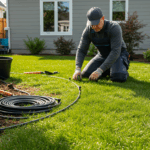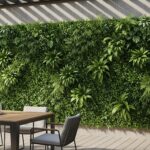Have you ever found yourself in a busy lobby or a bustling commercial environment and wondered how the flooring withstands all that foot traffic day after day? Flooring options for high-traffic areas are a rich topic, especially when balancing durability, aesthetics, and maintenance. My journey into choosing the right flooring for busy environments led me through a fascinating exploration of materials, each with its unique set of advantages and trade-offs. Before making a decision, it’s vital to understand how different flooring types can meet the needs of high-traffic areas.
Understanding High-Traffic Flooring Needs
To make an informed choice, one needs to grasp what “high-traffic” truly implies for flooring. High-traffic areas aren’t merely those that see a lot of footfalls; they endure constant use and often host various activities that could compromise flooring integrity. The right flooring must withstand wear and tear, maintain its appearance, and ensure safety.
Considerations include factors such as load-bearing capacities, slip resistance, and ease of cleaning, all of which are critical in ensuring the floor remains functional and safe over time. It’s not just about picking the sturdiest material; it’s about finding an option that’s practical and complements the overall aesthetic of your space. Here’s a table that breaks down the core needs:
| Criteria | Requirements | Considerations |
|---|---|---|
| Durability | High resistance to wear and tear | Material strength and thickness |
| Maintenance | Ease of cleaning and upkeep | Surface texture and color |
| Safety | Non-slip surfaces | Safety rating and texture |
| Cost | Affordability over lifecycle | Initial and maintenance costs |
Ceramic Tiles: A Popular Choice
Among the myriad options available, ceramic tiles stand out for their versatility and durability. In my exploration, ceramic tiles emerged as a top contender due to their hard, moisture-resistant surface, making them suitable for high-traffic zones like shopping malls or office lobbies. They are available in a range of colors and designs, offering the flexibility to complement any décor.
What captured my attention was their resilience. Ceramic tiles are incredibly tough, and when installed correctly, they can last decades without showing signs of wear. They are easy to clean and maintain, as most spills and dirt can be wiped away with minimal effort.
However, it’s essential to consider the cost of installation and potential need for grout maintenance over time. Ceramic tiles can be slippery when wet, so choosing a textured finish can enhance safety.
Vinyl Flooring: A Cost-Effective Solution
Vinyl flooring presented itself as a budget-friendly alternative with excellent performance under heavy use. This option isn’t just about being affordable; it delivers a significant return on investment due to its long-lasting nature. Available in sheets, tiles, or planks, vinyl can mimic the appearance of wood or stone, providing versatility in design.
What really stood out to me is vinyl’s resilience against stains and water damage, which is crucial in maintaining aesthetic appeal over time. The cushioned layer beneath the surface gives it a softer feel underfoot while still maintaining robustness. Installing vinyl is also relatively simple, making it a great DIY project for those so inclined.
The fabric of a space is defined by the ground you walk on; your flooring is the canvas on which your daily life paints its picture.
Explore the Wonders of Natural Stone
For those looking to make an impression, natural stone might be the perfect fit. Whether it’s marble, granite, or limestone, each type of stone brings a unique character to a space. During my research, I couldn’t help but marvel at the timeless beauty and luxury that natural stone exudes.
Stone products offer unparalleled durability, capable of withstanding harsh conditions and high traffic with ease. However, they do require regular sealing to maintain their luster and prevent staining. While the cost can be higher compared to other materials, the upscale appearance of natural stone often justifies the investment.
Engineered Hardwood: The Elegant and Durable Choice
Engineered hardwood flooring combines the beauty of natural wood with enhanced durability, making it an appealing choice for high-traffic areas like hotel lobbies or elegant retail spaces. The top layer is made of real wood, providing the authentic appearance of solid hardwood, while the underlying layers add stability and resistance to temperature changes.
In my search, I found that engineered hardwood is less prone to warping compared to solid wood and is easier to install. The variety of finishes and stains offers a wealth of customization options. However, it’s important to note that while engineered hardwood can be sanded and refinished, it has a limited number of refinishing opportunities compared to solid hardwood.
Luxury Vinyl Tile: Combining Aesthetics with Resilience
Luxury Vinyl Tile (LVT) takes the benefits of standard vinyl and enhances them with superior design options and increased durability. This option captured my attention because it allows for sophisticated designs, closely mimicking high-end materials like stone or wood, without the associated cost and maintenance.
LVT’s thick wear layer protects against heavy traffic, impacts, and scratches, making it ideal for commercial and residential applications alike. Its ability to resist moisture and stains means it’s easy to keep clean and maintain, ensuring that it remains attractive over time.
The Rise of Eco-Friendly Flooring Options
For the environmentally conscious, eco-friendly flooring materials such as bamboo and cork have gained popularity. These materials not only lessen the environmental impact but also offer unique aesthetic qualities. Bamboo, with its rapid growth rate, provides a sustainable source of material that is hard and durable. Cork, harvested from the bark of cork oak trees, offers excellent acoustic and thermal insulation properties.
These materials have piqued my interest due to their sustainability and contemporary look. However, they may not be suitable for all high-traffic settings due to their softer nature, potentially leading to dents or damage under heavy use.
Rubber Flooring: An Unexpected Contender
While rubber flooring might initially conjure images of gyms or playgrounds, it boasts characteristics that make it suitable for commercial high-traffic areas too. Its shock-absorbent nature, coupled with excellent slip resistance, offers both comfort and safety – two aspects I found particularly appealing during my investigation.
Rubber floors are durable, easy to clean, and provide significant noise reduction. Moreover, they are available in a wide range of colors and patterns. Although the upfront cost might be higher, the lifecycle cost makes it an investment worth considering for busy environments.
FAQ – Common Questions
Can ceramic tiles be used in outdoor high-traffic areas?
Ceramic tiles are suitable for outdoor use, especially when they have a textured finish that enhances slip resistance. However, ensure they are rated for exterior use to withstand weather conditions.
How often should vinyl flooring be replaced in high-traffic areas?
Vinyl flooring generally lasts between 10-20 years in high-traffic settings, depending on maintenance and the quality of installation.
Is natural stone slippery when wet?
Natural stone can be slippery when wet, but selecting a textured finish or applying a non-slip treatment can mitigate this risk.
What makes engineered hardwood better than solid wood for high-traffic areas?
Engineered hardwood is more stable and less susceptible to changes in temperature and humidity, making it a better choice for high-traffic areas.
Are eco-friendly flooring options durable enough for commercial spaces?
While eco-friendly options like bamboo and cork are durable, they may not be as resilient as materials like vinyl or ceramic in very high-traffic settings.
Conclusion
Deciding on the right flooring for high-traffic areas is a delicate balance between functionality, aesthetics, and budget. Each material brings its unique strengths to the table, ensuring there’s an option that fits every specific need and condition. Whether you prioritize durability, cost-effectiveness, or environmental sustainability, there’s a flooring solution out there for you. My journey through various flooring types highlighted the importance of choosing a material that not only withstands the rigors of daily life but also enhances the space it occupies. By considering factors such as durability, maintenance, and aesthetic appeal, you can ensure your flooring choice stands the test of time, providing a solid foundation for your environment.
Meta Descrição: Explore durable and aesthetic flooring options for high-traffic areas, from ceramic tiles to eco-friendly choices, ensuring long-lasting appeal and functionality.







